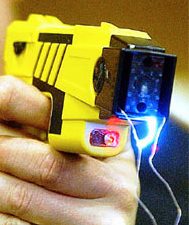IPCC calls for last-resort use of Taser and training review after device most likely cause of fire death
A Taser fired by a police officer is the most likely reason a fire started which engulfed and killed a man, an inquest jury concluded.
A Taser fired by a police officer is the most likely reason a fire started which engulfed and killed a man, an inquest jury concluded.
Troubled Andrew Pimlott had doused himself in petrol and was holding a lighted match when he was hit by the weapon in his parents` back garden.
A statement given to Plymouth Coroner`s Court said the officer PC Peter Hodgkinson, who had never deployed a Taser before that moment, had acted in line with his training before firing.
PC Hodgkinson insisted he fired the Taser in a bid to prevent Mr Pimlott hurting himself.
The jury, in returning a narrative verdict, said they could not be sure the 32-year-old had started the fire by striking the match. We believe that the Taser was the most likely source of ignition, they added.
Mr Pimlott died a few days later from severe burns after the fire in April 2013.
The Independent Police Complaints Commission (IPCC) cleared PC Hodgkinson of misconduct in March, and last October prosecutors rejected a criminal prosecution for gross negligence manslaughter and misconduct.
But today it issued a recommendation in the wake of the Taser incident victims death saying the device should only be used as a last resort in the presence of flammable substances.
And the IPCC has called on the National Police Chiefs Council and the College of Policing to revise their Taser training in order to provide a more comprehensive guide to officers when dealing with flammable liquids.
In a statement, Devon and Cornwall Police said it is cognisant of the impact the incident has had on the officers concerned.
PC Hodgkinson and another officer had gone to the house in the Honicknowle district of Plymouth after a 999 call from Mr Pimlott`s father, Kelvin, reporting his son was breaching a restraining order imposed by magistrates to stay away from the house.
Describing the scene as he came face to face with Pimlott, PC Hodgkinson said: He empties the contents of the jerry can as soon as I stepped around the corner. I believe I was shouting at him to put it down and was trying to engage.
I remember the raised voices, shouting, but dont remember the exact words said by either myself or Mr Pimlott but he was very upset, angry. I looked round and got my Taser.
As I looked up I saw a flame. I believe it was in his right hand. I tried to engage and shouted: Put it down, Taser trained or Taser officer.
I dont remember the exact words said but something to that effect. My thought at that time was that his intention was to set himself alight. Shortly after that he became engulfed in flames.
Forensic scientist Stephen Andrews told the jury it was his opinion as an experienced fire investigator that it was the Taser that ignited the petrol-soaked Mr Pimlott and not a lighted match.
He carried out a series of experiments to try to establish how Pimlott may have caught fire. Mr Andrews said: Overall my opinion is that my findings provide very strong evidence to support the view that Andrew Pimlott was set on fire by the Taser.
Officers were warned of the potential dangers of firing a Taser in the presence of flammable liquids, instructor PC Jonathan Reed told the inquest.
The inquest heard from an expert witness that PC Hodgkinson, who explained he thought Mr Pimlott was going to set himself alight, had followed national policing guidelines on using the Taser.
The IPCC statement said: Taser should only be considered for use in the presence of flammable substances as a last resort, and after every other available option has been considered and discounted.
The recommendation is included in the IPCC investigation report being published today, that examined events, including the discharge of Taser, surrounding the death of Andrew Pimlott in April 2013. Mr Pimlott died after suffering severe burns having doused himself in petrol. He was also Tasered during the incident.
Following the inquest Devon and Cornwall Police Chief Superintendent Jim Nye said: Any officer using Taser is subject to extensive trainin


